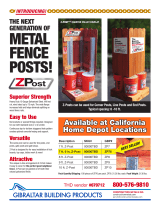
Building
the Deck
of a
Lifetime
Building
Fences
with Ease
Landscaping
with Timbers
Additional
Products
CLB0209
LIFETIME LIMITED WARRANTY
Covering your use of CA treated wood for as long as you own your home
or farm.
When used in an application which is consistent with the intended end use
identified on the product label or stamp and in conjunction with a residential or
agricultural structure located in the United States of America, then subject to
the conditions contained in this Warranty, your CA treated wood is warranted
against such damage by termites or fungal decay as would make the lumber
structurally unfit for the applications for which it was intended.
This warranty is good from the date of purchase for as long as you own the
property on which your new CA treated wood structures are built. This warranty
is applicable to the original purchaser and property owner only, and is not
transferable to any other property owner. The original consumer purchaser will
be entitled to be reimbursed for the actual, reasonable cost of new CA treated
wood which is purchased to replace wood which was made structurally unfit by
damage due to termites or fungal decay. To obtain the necessary prior approval
for, and make arrangements for, this reimbursement, the original owner must
se nd su f fic ient am ount of C A tre ated wood was o ri ginal ly pur chase d t o cover t he
number of board feet claimed to be damaged, to the Warrantor, at:
CA TREATED WOOD • Warranty Claim Administrator
L.D. McFarland Company
P.O. Box 1496 • Tacoma, WA 98401-1496 • www.mcfarlandcascade.com
When making any warranty claim you may be required to send photographs
and/or pieces of damaged wood. In addition, at the Warrantor’s request, the
Warrantor and its representatives and agents must per permitted to inspect and
test the damaged structure.
Warrantor shall not be liable hereunder for damage to CA treated wood
re sulti ng f ro m any c ase ot he r th an t er mite s or fung al dec ay, or fo r any d am age t o
wood which has been used in a structure outside of the U.S.; used in foundation
systems (such as the Permanent Wood Foundation, and piling, pole or heavy
timber type residential construction); used in swimming pool sidewalls; used as
fence posts, vineyard stakes or tree supports in agricultural applications; used
where immersed in salt water; used for commercial or industrial projects; used
in commonly owned property and structures such as condominiums; or used
for and application or in a way that is not consistent with the end use identified
on its original label stamp.
Warrantor shall not be liable for any installation, repair, construction, labor
or similar costs, or for any costs or damage which may be associated with
the natural characteristic of some wood to split, crack, warp, or twist. To the
maximum extent permitted by applicable law, in no event shall Warrantor be
responsible for any direct, indirect, incidental, consequential or financial damages
or expenses of any kind whatsoever, howsoever caused (whether or not due to
any deficiency or negligence in manufacturing, and whether or not relating to
loss, damage, death or injury) arising out of or relating to your purchase or use
of CA treated wood.
For hem-r, Douglas r, and western hemlock, this warranty is null and
void unless all cut ends and bore holes were properly coated at the time of
construction with a suitable wood preservative, such as End Cut Solution,
containing a minimum of 1% copper. Proof of purchase of the preservative is
also required. These species are covered by this only when used in the states
of Alaska, Arizona, California, Colorado, Idaho, Montana, Nevada, New Mexico,
Oregon, Utah, Washington, Wyoming and Hawaii (except for unincised decking
which does not meet AWPA recommended standards, which is specifically not
warranted by Warrantor in Hawaii).
By purchasing CA treated wood you accept this Warranty and hereby
acknowledge that this replaces all other representations, warranties, guarantees,
terms, covenants, agreements, promises, commitments, duties of care or
conditions (”Representations”), expressed or implied, statutory or otherwise,
ind ul gin g, q ualit y o r sui t abi lity, an d th er e ar e n o Rep re se nt at io ns w hats oe ver w it h
respect to CA treated wood except the specific warranty given hereunder. Only
the Warrantor is liable under this Limited Warranty and the directors, officers,
employees and agents shall have no liability of any kind to you or others with
respect to your purchase or use of CA treated wood.






























